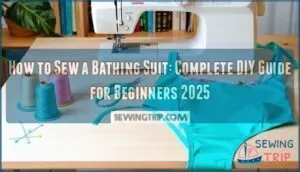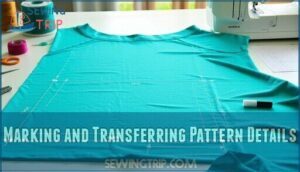This site is supported by our readers. We may earn a commission, at no cost to you, if you purchase through links.
 Learning how to sew a bathing suit starts with gathering the right materials—you’ll need nylon-spandex fabric with at least 10% Lycra, chlorine-resistant elastic, and ballpoint needles that won’t snag your stretch fabric. Cut your pattern pieces carefully, then use a serger or zigzag stitch to create flexible seams that move with your body.
Learning how to sew a bathing suit starts with gathering the right materials—you’ll need nylon-spandex fabric with at least 10% Lycra, chlorine-resistant elastic, and ballpoint needles that won’t snag your stretch fabric. Cut your pattern pieces carefully, then use a serger or zigzag stitch to create flexible seams that move with your body.
The trickiest part is applying elastic with just the right tension—too tight and you’ll create puckers, too loose and your suit won’t stay put. With polyester thread that resists pool chemicals and proper stretch stitches, your handmade swimsuit will outlast store-bought options.
The secret lies in mastering a few specialized techniques that transform tricky stretch fabrics into professional-looking swimwear.
Table Of Contents
Key Takeaways
- You’ll need specific materials – Choose nylon-spandex fabric with at least 10% Lycra, chlorine-resistant elastic, ballpoint needles, and polyester thread that won’t break down in pool chemicals.
- Master elastic application tension – Stretch your elastic to roughly 80% of the seam length while sewing to prevent puckers and ensure your suit stays put during wear.
- Use proper stretch stitches – Select zigzag or triple stretch stitches on regular machines, or use a serger for the strongest seams that won’t snap under pool pressure.
- Follow smart care practices – Rinse immediately after swimming, hand wash in cold water, air dry flat in the shade, and rotate between suits to double your swimsuit’s lifespan.
Gather Essential Swimwear Sewing Supplies
Success with swimwear sewing starts with gathering the right materials before you begin your project. You’ll need nylon-spandex fabric with at least 10% Lycra content, chlorine-resistant elastic, powermesh lining, ballpoint needles, and polyester thread that won’t break down in pool chemicals.
Start with quality materials and your swimwear project succeeds before you even thread the needle
Choosing High-quality Fabric (nylon, Spandex, Power Mesh)
Quality fabric selection sets your swimwear project up for success. Choose nylon blends with 10-20% spandex for ideal material stretch and durability. Shop fabric stores or sewing supplies online for swimwear textures that offer four-way stretch and chlorine resistance. Power mesh adds targeted support while maintaining elastic properties throughout repeated wear. When selecting fabrics, consider the importance of swimwear fabric properties for a successful project.
Selecting Chlorine-resistant Elastic and Lining
Your swimsuit’s longevity depends on choosing elastic with high chlorine resistance and stretch recovery properties. Look for polyurethane-based elastic that maintains tension after repeated exposure to pool chemicals.
For lining materials, select nylon-spandex blends that won’t deteriorate quickly.
Quality sewing supplies online offer specialized swimwear fabrics and sewing notions designed for aquatic environments, ensuring your handmade suit withstands countless swimming sessions.
Picking The Best Thread and Needles for Swimwear
Since choosing the right thread and needles determines your swimwear’s durability, you’ll want polyester thread for chlorine resistance and ballpoint needles sized 75/11 or 80/12.
Here’s your Thread Selection and Needle Types checklist:
- 100% polyester thread resists pool chemicals and UV damage
- Ballpoint needles glide through stretch fabrics without snagging
- Size 75/11 or 80/12 provides ideal Fabric Compatibility
Replace needles after each project to maintain quality stitches. For best results, consider using polyester thread options to guarantee the best material for your swimwear.
Essential Tools—rotary Cutter, Serger, and Sewing Machine
Beyond thread and needles, your sewing arsenal needs power tools that’ll turn fabric-cutting marathons into quick sprints. Rotary cutters slice through multiple layers like butter, while sergers create professional seams that won’t snap under pool pressure. Your trusty sewing machine becomes the command center.
| Tool | Best Feature | Why You Need It |
|---|---|---|
| Rotary Cutter | Clean, precise cuts | Saves time on curved seams |
| Serger Machine | Professional finish | Prevents seam failure |
| Sewing Machine | Stretch stitch capability | Manages swimwear fabrics |
| Fabric Shears | Sharp, clean edges | Backup cutting precision |
These sewing tools transform your sewing studio into a swimwear production hub. Quality sewing machines with stretch settings prevent skipped stitches, while rotary cutters guarantee accurate pattern pieces. Many sewing workshops emphasize these serger tips: proper tension creates durable seams that withstand chlorine and movement. Investing in a rotary cutter tool is vital for efficient fabric cutting and professional results.
Select and Prepare Your Bathing Suit Pattern
Choosing the right pattern sets the foundation for your swimsuit success, so you’ll want to start with designs specifically created for stretch fabrics and beginner sewers. Look for patterns that include detailed instructions, seam allowances, and clear size charts—these features will save you hours of frustration and help guarantee your finished suit actually fits.
Sourcing Beginner-friendly and Modern Patterns
With your supplies ready, you’ll want patterns that won’t leave you drowning in complexity. Modern Designs from Mood Fabrics offer free downloads with step-by-step guidance, while Beginner Tips from Ellie and Mac provide foolproof instructions. Choose Pattern Selection that matches your skill level—think training wheels for your sewing journey. Utilizing free swimsuit patterns can greatly simplify the process for beginners.
- Free patterns from Mood Fabrics – Over 10 modern swimsuit patterns with zero cost barrier
- Beginner-focused brands like Jalie – Clear instructions that won’t make you want to throw your machine out the window
- Size-inclusive options – Patterns spanning sizes 00-32 so every body gets beach-ready
- Video Sewing Tutorials – YouTube sew-alongs that feel like having a patient friend guide you
- Community support access – Reddit forums and pattern reviews from real sewists who’ve been there
Understanding Pattern Placement and Grainline
Once you’ve chosen your pattern, proper grainline orientation becomes your roadmap to success. Align pattern pieces with fabric grain direction to maintain your swimsuit stretches correctly and maintains its shape. Most sewing patterns include grainline arrows that should run parallel to the fabric’s selvage edge.
Pay attention to pattern alignment on stretchy materials—they behave differently than woven fabrics. Proper cutting strategies and seam matching start with understanding how fabric grain affects your final fit. Understanding the fabric grain basics is vital for achieving a professional-looking swimsuit.
Adjusting Patterns for Fit and Style Preferences
Pattern modifications let you break free from standard sizing limitations and create your perfect fit. Start with measurement techniques that compare your body to the pattern’s sizing chart, then make fit adjustments by lengthening torsos or widening bust areas. Style customization options include changing necklines or leg cuts.
Many sewing studios offer sewing workshops focused on pattern modifications, while sewing education resources provide guidance on sizing options and sewing notions needed for alterations.
Cut and Prep Swimwear Fabric Correctly
Properly cutting your swimwear fabric sets the foundation for a professional-looking bathing suit that fits like it was custom-made. You’ll master pre-washing techniques, strategic layout methods, and stretch-fabric cutting skills that prevent costly mistakes and guarantee your finished suit moves with your body perfectly.
Pre-washing and Drying Swim Fabrics
Pre-washing swim fabric prevents color bleeding and fabric shrinkage that could ruin your finished swimsuit. This step removes manufacturing chemicals and excess dye from your fabric and notions before you start sewing.
Here’s how to pre-wash swimwear fabric properly:
- Hand wash in cold water with mild detergent to protect stretch fibers
- Add white vinegar (2 tablespoons) for dark colors to prevent color bleeding
- Use gentle machine cycle with mesh bag for fabric softening protection
- Air dry flat on towels away from direct sunlight for proper drying methods
- Skip the dryer completely to prevent shrinkage prevention
Using the right sewing techniques is vital for a successful project. Your sewing studio preparation pays off when your handmade swimsuit fits perfectly after the first wash.
Efficient Fabric Layout and Pinning Tips
Efficient layout strategies transform your sewing studio environment into a cutting powerhouse. **Position pattern pieces to minimize fabric waste while respecting grainlines.
** Use pattern weights instead of pins on stretchy materials—they won’t distort the fabric.
Smart fabric optimization means folding your material strategically and planning cuts before making the first snip.
Cutting Techniques for Stretch Fabrics
Sharp rotary cutters slice through swimwear fabrics like butter, but you’ll need steady hands for Fabric Stability. These Cutting Tools work best on stretch materials:
- Rotary cutters – Roll smoothly without pulling fabric fibers
- Sharp fabric shears – Cut clean edges on nylon-spandex blends
- Pattern weights – Hold pieces steady during Grain Alignment cuts
Master Fabric Optimization by cutting all pieces in the same direction for consistent Stretch Patterns. Understanding fabric stretch properties is essential for achieving the best results in swimwear fabrication.
Marking and Transferring Pattern Details
Accurate Pattern Marking sets the foundation for professional-looking swimwear construction. You’ll need fabric-safe marking tools from any sewing studio’s collection of sewing tools and equipment. Use tailor’s chalk or washable markers for Detail Transfer onto stretch materials.
Creative sewing requires precision during Fabric Preparation—mark notches, darts, and seam allowances carefully. These Accuracy Tips from sewing education guarantee your sewing services result matches commercial quality swimwear construction standards.
Sew Bathing Suit Seams and Elastic
Now you’re ready to transform fabric pieces into a professional-looking swimsuit that’ll actually stay put during your beach volleyball game.
The key is mastering stretch stitches and elastic application, which can make the difference between a suit that lasts one season and one that becomes your go-to for years.
Using Stretch Stitches or a Serger for Strong Seams
Now that your fabric pieces are ready, choose the right stitching method to keep your swimsuit together through countless pool sessions. Serger machines create the strongest seams for swimwear since they form flexible overlock stitches that stretch with your body.
If you’re using a regular sewing machine, select stretch stitching like zigzag or triple stretch—these accommodate fabric tension without breaking. **Your thread selection matters too; polyester thread paired with ballpoint needles prevents skipped stitches on stretchy materials.
Attaching Lining and Power Mesh for Support
Proper lining techniques transform your swimsuit from flimsy to fabulous. You’ll attach power mesh to support panels using stretch stitches, creating invisible reinforcement. Pin lining pieces to main fabric with right sides together, then sew using a narrow seam allowance.
The power mesh acts as your secret weapon for bust support without bulky padding. Focus on seam construction that won’t show through—your fabric stabilization game just leveled up substantially.
Applying Elastic With The Right Tension
Mastering elastic application transforms your swimsuit from floppy to fabulous. You’ll stretch the elastic to roughly 80% of the seam length while sewing to achieve perfect tension control and stretch recovery.
- Pin elastic at quarter points to distribute tension evenly across the seam
- Use a ballpoint needle to prevent snagging delicate swim fabric during application
- Test stretch recovery by pulling the sewn elastic – it should snap back smoothly
- Maintain consistent seam stability by keeping fabric flat while guiding elastic through machine
To achieve professional results, understanding elastic casing techniques is vital for a polished finish.
Tips to Avoid Skipped Stitches and Fabric Damage
Skip your thread tension battles by switching to ballpoint needles—they slide between fibers instead of piercing them. Set your stitch length to 3mm for stretch fabrics and use gentle fabric handling when feeding material through your machine.
Test seam reinforcement on scraps first, and keep your sewing tools sharp for clean cuts during trims hemming.
Finish, Fit, and Care for Your Handmade Swimsuit
You’re now ready to perfect the fit and finish of your custom swimsuit. These final steps guarantee your handmade suit looks professional and lasts through countless beach days.
Checking and Adjusting Fit With Expert Tips
Slip into your swimsuit before adding elastic to check coverage and compression. Your handmade suit should feel snug without pinching—think second skin, not straightjacket. Use Body Measurements against Sizing Charts for Fit Adjustment comparisons.
Mark problem areas with chalk during Sewing Fittings, then make Garment Alterations in half-inch increments. Learn To Sew these adjustment techniques at Sewing Studio Rentals with proper Sewing Tools and Equipment guidance.
Trimming, Hemming, and Adding Final Details
With your swimsuit perfectly fitted, focus on clean Edge Trimming to remove excess seam allowances. Use sharp Sewing Tools and Equipment for precise cuts, leaving quarter-inch margins.
Apply proper Seam Finishing techniques like serging raw edges to prevent fraying. For Hemming Techniques, fold edges evenly and sew with stretch stitches.
Add Detail Embellishments or decorative Trims if desired, securing them with appropriate Binding Methods.
Best Practices for Washing and Long-lasting Wear
Proper care transforms your handmade swimsuit from a single-season wonder into a lasting wardrobe staple. Smart Fabric Care Tips from the Sewing Community prevent premature wear and preserve your investment.
- Rinse immediately after swimming to remove 90% of chlorine and salt
- Hand wash with gentle detergent using cold Wash Cycle Settings
- Air dry flat in shade using proper Drying Methods for Color Preservation
- Rotate suits between wears to let fabric fibers recover fully
Following these Home Sew-approved techniques doubles your swimsuit’s lifespan while maintaining stretch and preventing Shrinkage Prevention issues. To maintain the quality of your handmade swimsuit, understanding fabric shrinkage prevention is essential for its longevity.
Frequently Asked Questions (FAQs)
What are some common mistakes to avoid when sewing a bathing suit?
Like medieval armor-makers crafting protection, you’ll avoid swimwear disasters by using proper stretch needles, pre-washing fabric, maintaining consistent seam allowances, choosing appropriate thread, and ensuring adequate stretch in your stitches for flexibility.
How do I determine the grainline and direction of greatest stretch in my fabric?
Grasp your fabric at one corner and stretch it in different directions to find maximum give. The grainline runs parallel to the selvage edge, while cross-grain stretches most.
Is it necessary to use a serger when sewing a bathing suit?
While not absolutely essential, a serger creates the strongest seams for your suit’s demanding aquatic adventures. You can achieve professional results using a regular machine’s zigzag stitch instead.
What are some tips for achieving precise pattern placement in swimwear?
Match your fabric’s stretch direction to pattern pieces for ideal fit. Test placement on scraps first, marking grainlines clearly. You’ll prevent wonky suits that twist uncomfortably.
How do I choose the right size pattern?
Measure yourself carefully at bust, waist, and hips, then compare those measurements to the pattern’s size chart. Choose based on your largest measurement since you can always take in smaller areas during fitting.
Can I sew swimwear without a serger machine?
Don’t put all your eggs in one basket – you can absolutely create swimwear using a regular sewing machine.
Use stretch or zigzag stitches to maintain fabric flexibility and prevent seam breakage during wear.
Whats the best way to try on during construction?
Try your suit on frequently during construction, especially after completing each major seam. Pin-fit the partially assembled pieces to check coverage and fit before finalizing seams permanently.
How do I prevent fabric rolling while cutting?
Picture slippery stretch fabric trying to escape your scissors like a wiggling fish.
Use pattern weights instead of pins, rotary cutters with sharp blades, and cutting mats underneath for clean edges.
Should I use interfacing in swimwear construction?
Generally skip interfacing in swimwear construction. Stretch fabrics need flexibility to move with your body, and interfacing restricts that natural give. Instead, use powermesh lining for support without sacrificing comfort or mobility.
Conclusion
Ironically, while store-bought swimsuits fall apart after one season, your handmade creation will outlast them all. You’ve mastered how to sew a bathing suit using professional techniques that most manufacturers skip.
Your chlorine-resistant materials and proper stretch stitches create swimwear that actually improves with wear. The investment in quality supplies pays off when you’re still wearing your custom suit years later while others shop for replacements.
- https://docs.google.com/forms/d/1GAQr3Kn1cURCVHUA82hAga1Wv8DCH0IuqDLRUrOpN7M/viewform?ts=63f4f653&entry.1515682415=https://www.merriam-webster.com/dictionary%2Fsew
- https://premium.britannica.com/mw-unabridged/?utm_source=mw&utm_medium=inline-def&utm_campaign=evergreen
- http://mailto:hello?subject=SIA%20Question
- https://maps.google.com/?daddr=7051%20Germantown%20Ave
- https://www.youtube.com/watch?v=vl5UYOPmxIc
















